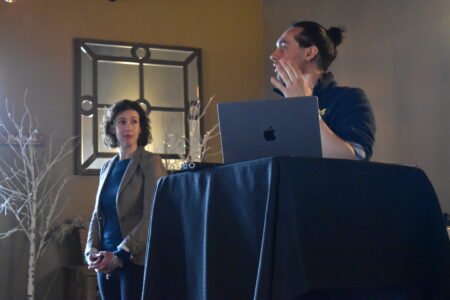Tech innovation fills 3-D printers
HOUGHTON – The process of 3-D printing is becoming so common, there are printers in schools, businesses and possibly even homes, but the plastic filament for the printers is fairly expensive, so Joshua Pearce’s students are working on a project to bring the cost of filament down.
Pearce, who is a Michigan Technological University associate professor in materials science and engineering, and electrical and computer engineering, and faculty advisor for the Tech open source hardware enterprise, said students are working to create a method to make the plastic filament needed for 3-D printing from waste plastic, such as soft drink bottles.
His students are developing a device called a recyclebot, which will use shredded or pelletized waste plastic to make the filament. Funding for the project comes from a $25,000 grant from the Ford College Community Challenge. The effort is part of the Tech Enterprise program.
“It’s essentially a student-run business,” he said.
The business is non-profit and uses “open-source,” or free, software, Pearce said.
“Nobody’s holding stock and nobody’s making a salary,” he said.
The process for 3-D printing melts the filament in the printer. A design for a final product is created on a computer, and the printer puts down layers of plastic, or metal, until the product is is completed.
Besides being a business, Pearce said the 3-D printing program is actually a class, and students have specific tasks they need to accomplish to successfully complete the class.
Students have a choice of two paths in the class, Pearce said, either senior design or Enterprise. They can start as early as their freshman year, in which case they’d stay with the class for their four years as an undergrad. Being with the program for four years could help a student get a job later.
“Industry likes that, because they like to see a student mature,” he said.
As part of the class, Pearce said students must create a business plan to sell completed filament makers.
Pearce said students are currently working on a prototype machine which turns shredded or pelletized waste plastic into the filament.
“The students did the design last year,” he said.
Students use a paper shredder to create the raw plastic for the filament maker, Pearce said. They also have access to a pelletizer to make plastic pellets.
There is massive potential for other people who may want to make a for-profit company creating plastic filament, Pearce said. The current cost for filament or pellets is about $30 per kilogram, but the filament his students are creating costs about $5 per kilogram to make.
Because of the profit potential, Pearce said one idea for the filament maker is to offer it to people in developing countries where many people gather waste plastic then bundle it to sell for a few dollars a ton. With a solar-powered filament maker, they can sell filament made from the waste they collect for more money than they get for bundled plastic.
“The Enterprise (project) is going to prove it’s possible,” he said.
Within the Tech community, Pearce said there are at least 100 students with 3-D printers. There is a possibility students could create items for other instructors on campus.
“There’s an enormous pent-up demand here,” he said.




